|
FAQs About Dojos, Weatherfishes
Health/Disease 4
Related Articles: Dojo Use
in Ornamental Ponds, Loaches,
A New Look At
Loaches By Neale Monks,
Related FAQs: Dojos/Weatherfishes Health 1,
Dojo Health 2, Dojo
Health 3, Dojo Health 5, Dojo/Weatherfishes 1,
Dojos/Weatherfishes 2, & FAQs on:
Dojos/Weatherfishes Identification,
Dojos/Weatherfishes Behavior,
Dojos/Weatherfishes Compatibility,
Dojos/Weatherfishes Stocking/Selection,
Dojos/Weatherfishes Systems,
Dojos/Weatherfishes Feeding,
Dojos/Weatherfishes Reproduction, &
Loaches 1,
Clown Loaches, &
Loach Identification,
Loach Behavior,
Loach Compatibility,
Loach Selection,
Loach Systems,
Loach Feeding,
Loach Disease,
Loach Reproduction,
|
|
|
Dojo Loach Selling and blisters: Suggestions for care?
11/17/20
Hi there- You were so incredibly helpful last time, I thought I would try
again. I have a scenario that I can't find any information on and I thought
maybe you would have insight.
<Okay; will respond here and refer this to Neale Monks for his independent
input>
This is the second time I've gotten a Dojo (weather) loach into the rescue
with Edema (swelling) and blisters on their body.
<Mmm; yes. Unfortunately this situation is quite common. Something about
Misgurnis in captive conditions>
The first had been in that state for a year, after jumping out of her tank
and being mostly dry when she was placed back in the water. I had her for
six months before I put her to sleep because she had swelling all throughout
her body, and had trouble breathing and swimming. I tried everything from
Epsom salt baths 2x a day (for about 3 weeks), to antibiotics for potential
bacterial infections, with no change.
Recently, I got another Dojo in. He was sickly when I got him, but did not
have the swelling. About a month after being in the tank with goldfish and
Dojo's (150 g, 7 dojos, and about 10 adolescent Goldfish, 2x a week water
changes and quad filtration), I noticed he was swollen starting from mid
body to tail. I Quarantined him, along with all the rest of the loaches for
a few days to make sure no one else was showing anything weird (dojo's in a
150 are a tad bit difficult to keep an eye on), but he is the only
one experiencing this.
I have been giving him some Epson salt baths, though not as frequently as
with the other dojo, he shed his slime coat after the first bath, and then
developed the blisters, which have not subsided. He is still active, and
still eating- but the swelling has not changed and I'm not sure what to do
for him. He's now been in QT for about a month with no real change to his
edema. He also developed a small white patch on his head- not fuzzy or a
wound- just a pigmentation change from what I can tell.
I apologize that the photos are not better- it's not a well-lit tank and
he's a wiggly little guy- but hopefully, it's enough to provide some
suggestions? I can get better photos if that would be helpful, but they
would involve stressing him out a little bit, so I figured I would wait to
see what you needed.
Respectfully,
Andie Lamantia
The Fish Haus Aquatic Rescue
<I'll (simply) refer you to past replies (myself) as I have no new material
to add here:
http://www.wetwebmedia.com/dojodisF4.htm
and the linked files above in this series.
Thank you for your efforts. Bob Fenner:
Re: Dojo Loach Selling and blisters: Suggestions for care?
11/17/20
Awesome! Thanks so much. I'm sorry I did not stumble on this myself!
<No worries Andie. BobF>
Dojo Loach Selling and blisters: Suggestions for care? /Neale
11/17/20
<<Like Bob, I've seen this a few times with Misgurnus species. It does seem
to be environmental. One suggestion is that it's a form of the gas-bubble
disease you sometimes see in marine fish. If you expose the fish to sudden
changes in water temperature (such as adding too much icy cold water to the
tank) the saturation of gases in the aquarium water change, and if those
gases come out of solution within the fish, any bubbles that tend to move
outwards become visible under the skin. There may be some mileage in this
explanation, because Weather Loaches are habitual air-gulpers, so tend to
have more air inside them than the average fish. They're also more prone to
swimming rapidly up and down the tank, and while I can't imagine the
pressure difference is very great, it may be enough to make a difference to
the solubility of any gases in their blood. Another suggestion that's
perhaps easier to understand is these are mud-dwelling fish poorly adapted
to gravelly substrates. Their skins are easily scratched, and rather as you
see with Spiny Eels extremely commonly, secondary infections ensure. My
problem with this explanation is that the bubbles are apparently under the
epidermis, not abscesses or something working their way from the outside in.
Either way though, optimising the environment and using antibiotics
against a secondary infection is likely your best move. I'd also warmly
recommend Loaches.com as a website with a forum populated with people who
are very into loaches. You might find someone there who can help with more
certainty! Regards, Neale.>>
|
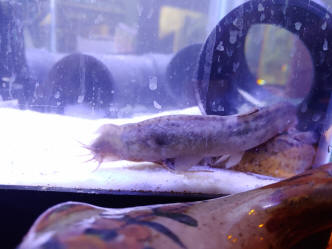
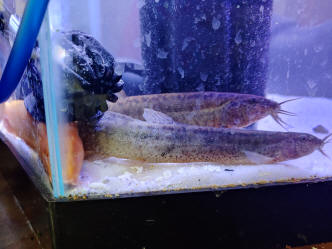 |
Sick Loach 1/30/19
I’m hoping you will be able to help me. I’ve had a sick loach for about
two or three weeks now. He is an albino loach.
<What sort of loach? Like a Weather Loach?>
All of a sudden he stopped being active. He would always race
back-and-forth across the tank. Then he started just to lay on the
bottom which he did sometimes before because that’s what loaches do but
now that’s all he did.
<Indeed. Both typical behaviours.>
As time went on I would find him laying on his side. Sometimes I would
even find him upside down. We thought it may be swim bladder, but he
never floats he just lays on the bottom.
<Loaches have a small swim bladder. Like other bottom dwellers, they've
evolved to sink in the water, unlike midwater fish that hang in the
water whenever they stop swimming. So while they certainly can get
constipation, you probably wouldn't see the "floaty, bloaty" situation
we associate with, say, Goldfish.>
The first one or two weeks, he would eat. Now he hasn’t eaten for a
while. I tried to feed him a pea to see if it would help in case it was
swim bladder. He would refuse to eat the pea and has been laying on his
side ever since.
<There are other high-fibre alternatives that Loaches may go for. Try
brine shrimp for a start. Frozen is probably easier for them to eat than
live. Avoid dried foods though! These do seem to make constipation more
likely.>
I have tried using Melafix and Pimafix but neither seem to work.
<Rarely do. Neither are reliable medications for anything. If you
suspect a bacterial infection, always a proper antibiotic (or failing
that, reliable antibacterial such as eSHa 2000 or Myxazin). Bacterial
infections tend to manifest other symptoms, including reddish patches on
the flanks and especially the belly, even if the obvious dropsy or fin
rot aren't visible.>
Another concern is that sometimes he will stop breathing for around 20
to 30 seconds but then he will start breathing again. In addition I have
also tested the water for pH, ammonia, and many other things.
<Could we have these values? Weather Loaches at least prefer relatively
mild temperatures (18-22 C is probably optimal) and may get stressed in
tropical tanks if kept thusly. They dislike extremes of pH and hardness,
and around neutral to slightly basic, medium hardness water is probably
optimal. Ammonia and nitrite should, of course, be zero.>
I was just hoping you would be able to help me. Thank you.
Abby
<Hope this helps, Neale.>
Re: Sick Loach 2/3/19
Thank you for the recommendations!
<You're welcome.>
I will look at getting one of the medicines you recommended above.
<Good.>
My fish is a dojo loach.
<A nice fish. One of the Weather Loach species.>
These are the conditions of my tank.
PH - 7.6
Ammonia - 0.25
<This really should be zero. Do compare with your tap water. If it is
also 0.25, then the ammonia isn't a problem with filtration, but you
will need to use an ammonia-neutralising water conditioner.>
Temperature - 23 C
<Much too high, and likely a stress factor. Aim for around 18 C; i.e., a
cool room temperature. High temperatures are fine in summer, and the
fish will gulp air during such seasons, but long-term care requires cool
winters as well.>
Nitrite - 0
Nitrate - 5
I hope that this is enough information for you to help me. Thanks for
the information you have already given me.
Abby
<Hope this helps. Cheers, Neale.>
Sick Loach 1/30/19
I’m hoping you will be able to help me. I’ve had a sick loach for about
two or three weeks now. He is an albino loach.
<What sort of loach? Like a Weather Loach?>
All of a sudden he stopped being active. He would always race
back-and-forth across the tank. Then he started just to lay on the
bottom which he did sometimes before because that’s what loaches do but
now that’s all he did.
<Indeed. Both typical behaviours.>
As time went on I would find him laying on his side. Sometimes I would
even find him upside down. We thought it may be swim bladder, but he
never floats he just lays on the bottom.
<Loaches have a small swim bladder. Like other bottom dwellers, they've
evolved to sink in the water, unlike midwater fish that hang in the
water whenever they stop swimming. So while they certainly can get
constipation, you probably wouldn't see the "floaty, bloaty" situation
we associate with, say, Goldfish.>
The first one or two weeks, he would eat. Now he hasn’t eaten for a
while. I tried to feed him a pea to see if it would help in case it was
swim bladder. He would refuse to eat the pea and has been laying on his
side ever since.
<There are other high-fibre alternatives that Loaches may go for. Try
brine shrimp for a start. Frozen is probably easier for them to eat than
live. Avoid dried foods though! These do seem to make constipation more
likely.>
I have tried using Melafix and Pimafix but neither seem to work.
<Rarely do. Neither are reliable medications for anything. If you
suspect a bacterial infection, always a proper antibiotic (or failing
that, reliable antibacterial such as eSHa 2000 or Myxazin). Bacterial
infections tend to manifest other symptoms, including reddish patches on
the flanks and especially the belly, even if the obvious dropsy or fin
rot aren't visible.>
Another concern is that sometimes he will stop breathing for around 20
to 30 seconds but then he will start breathing again. In addition I have
also tested the water for pH, ammonia, and many other things.
<Could we have these values? Weather Loaches at least prefer relatively
mild temperatures (18-22 C is probably optimal) and may get stressed in
tropical tanks if kept thusly. They dislike extremes of pH and hardness,
and around neutral to slightly basic, medium hardness water is probably
optimal. Ammonia and nitrite should, of course, be zero.>
I was just hoping you would be able to help me. Thank you.
Abby
<Hope this helps, Neale.>
Re: Sick Loach 2/3/19
Thank you for the recommendations!
<You're welcome.>
I will look at getting one of the medicines you recommended above.
<Good.>
My fish is a dojo loach.
<A nice fish. One of the Weather Loach species.>
These are the conditions of my tank.
PH - 7.6
Ammonia - 0.25
<This really should be zero. Do compare with your tap water. If it is
also 0.25, then the ammonia isn't a problem with filtration, but you
will need to use an ammonia-neutralising water conditioner.>
Temperature - 23 C
<Much too high, and likely a stress factor. Aim for around 18 C; i.e., a
cool room temperature. High temperatures are fine in summer, and the
fish will gulp air during such seasons, but long-term care requires cool
winters as well.>
Nitrite - 0
Nitrate - 5
I hope that this is enough information for you to help me. Thanks for
the information you have already given me.
Abby
<Hope this helps. Cheers, Neale.>
Yellow weather loach w red areas on body
8/6/18
Very concerned. Loach has red areas, first near tail, now half
of body after severe stress w tap water high in ammonia (4 ppm) w me not
finding right away.
<Aye; deadly toxic; likely the principal source of trouble here;
particularly in more alkaline water ammonia is very dangerous>
Several days of frequent water changes, some lost fish, other parameters
normal to tank, but very hard to get ammonia down....added prime often,
know this detoxes but doesn't remove. Thus not sure exactly how bad in
actual tank. Purchased spring water for changes.
Now loach has red areas, very inactive, sure he doesn't feel good.
Don't know how to help him or if euthanasia is best. Really like this
guy, hate to see him suffer.
<Am a laggard in terms of euthanizing livestock that has a chance to
recover. This loach species is very tough>
Had an ammonia spike a few months ago, managed to save everyone. This
time more severe.
Please help. Larry is a friend. About 1 yr old, 7 in long.
<Do take a read over our archives on Dojos:
http://www.wetwebmedia.com/fwsubwebindex/DojoHlthF.htm
and the linked files above. DO what you can to get rid of the ammonia.
SEE as in read on WWM re; chemical filtrants are the route I would go
NOW. Bob Fenner>
Re: Yellow weather loach w red areas on body
8/6/18
So far reading nothing like my guy.
No bumps
No blisters
No holes
No black spots
<These symptoms may well be forthcoming w/ exposure to ammonia>
Yes to red area beginning whole diameter of body first in front of tail
but now after 3 days extended to middle of body.
Weak, falls to side of tries to swim, stays next to objects as if to
maintain position
Not sure if eating but does move somewhat but not when I'm near...then
struggles
Was breathing rapidly 4 days ago, gradually now more normal Nitrate <30,
nitrite 0, ammonia now 0,25 ppm
<Better; but do shoot for less than 20 ppm of NO3, zero, zip, nada
ammonia 0.0>
Tap water now 1ppm
Spring water ammonia 0
<See Neale is taking on. Cheers, B>
Re: Yellow weather loach w red areas on body
8/6/18
Thank you
Will read
Do have ammonia filter on tank
Water is more acidic than alkaline, 6.2 to 6.4
<I would slowly raise this to about neutral; seven-ish. See WWM re easy
means to do this... likely baking soda, sodium bicarbonate... added,
mixed into your weekly water change out water>
Yes, I hate to end him if I don't have to.
<I would not do so. BobF>
Yellow weather loach w red areas on body /Neale 8/6/18
Very concerned. Loach has red areas, first near tail, now half of body
after severe stress w tap water high in ammonia (4 ppm) w me not finding
right away.
<If red areas are on underside of the body, around the mouth and belly
especially, I'd be looking at the substrate. Loaches are extremely
sensitive to abrasive substrates, as well as 'dirty' substrates that are
not cleaned or exposed to robust water currents.>
Several days of frequent water changes, some lost fish, other parameters
normal to tank, but very hard to get ammonia down....added prime often,
know this detoxes but doesn't remove.
<Water condition will neutralise ammonia in tap water. Once this is
done, it is harmless. So you can ignore it. But if your aquarium ammonia
level is higher than your tap water ammonia level, that is a problem. It
means there's ammonia being produced by the fish that isn't being
removed by the filter. Review stocking and filtration rates, and act
accordingly.>
Thus not sure exactly how bad in actual tank. Purchased spring water for
changes.
<What is the water chemistry of the tap water? Do bear in mind spring
water isn't necessarily idea for all fish! Weather Loaches appreciate
water that isn't too hard or too soft, with an around neutral pH; maybe
5-20 degrees dH, pH 6.5-7.5, and not too warm either, 18-22 C being
ideal.>
Now loach has red areas, very inactive, sure he doesn't feel good. Don't
know how to help him or if euthanasia is best. Really like this guy,
hate to see him suffer.
<I bet.>
Had an ammonia spike a few months ago, managed to save everyone. This
time more severe.
<Sounds like it. Do see above, and reply if necessary.>
Please help. Larry is a friend. About 1 yr old, 7 in long.
<Good luck, Neale.>
Re: Yellow weather loach w red areas on body
8/7/18
Thank you.
<Welcome.>
Redness not trauma related. Began near tail, whole circumference, then
spread forward toward head. Internal, not external.
<Could be anything, really. Sounds bacterial, so an antibiotic would be
the best call.>
BETTER today, more close to normal color. This a yellow guy, did I say
that? Perhaps moving a little better, as well. I do add Prime to all
water plus Stability, including spring. All tank parameters had been so
fine for several months. Frustrating. The city gives no warning of
ammonia spike.
<Indeed, but should be within certain limits. Double-dosing your water
conditioner isn't the worst idea, but in any event, use an ammonia test
kit on your tap water before doing a water change, and then add extra
conditioner if required.>
I understand many cities routinely add but alert residents. Not
Philadelphia. I will have to check for each day of collecting I am
learning, and take precautions. I hate harming the fish. Fingers crossed
that Larry is improving. Thank you again.
<Well, does sound frustrating. But good luck with Larry. Cheers, Neale.>
|
Ghosty: Costia? 11/19/17
Hi there!!
<Hello Wendy,>
Since we last corresponded, Ghosty has been doing relatively well.
<Good-oh.>
As a recap, I treated the tank with two cycles of Furan-2 to see if it would
help Ghosty’s symptoms of a cloudy, clamped dorsal fin & lots of slime floating
around in the tank (although I never witnessed it sloughing off of him in
particular). I do believe he felt better after the first treatment, & acted more
like his normal self, but about two weeks afterwards, his fin became clamped &
cloudy again so I treated with Furan-2 again.
I didn’t really see much improvement after the second treatment, so I began
researching everything I could re Costia, the other potential issue Neale
mentioned. I settled on treating with ParaGuard, & am pleased to say that after
two weeks of this treatment plus keeping the tank between 80-81 degrees, his
dorsal fin looks clear & isn’t as clamped although the bones are curved - much
like his tail. Don’t know why. The floating some patches have decreased
SIGNIFICANTLY and I’ve only seen one small patch in the last 10 days or so.
<Ah! The plot thinnens, as they say.>
Ghosty developed two lumps near his tail over the past 6 months or so - tumors?
<Possibly. In aquarium fish, actual cancerous tumours are relatively rare, but
they do happen -- primarily in species genetically predisposed to them, notably
goldfish and Bettas. In other fish, lumps can and often do have other
explanations: viruses, environmental stress, dietary shortcomings, even
bacterial infections such as Mycobacteria.>
And for the last week, a red spot has developed in each one. He continues to act
& feed normally. Is this a reaction to ParaGuard?
<Really hard to say. As/when you conclude the treatment as per the instructions,
do a series of water changes, and ideally use carbon in the filter for a week or
two. Basically, expose the fish to good, clean water and see what happens.
Optimising diet, especially with regard to vitamins and minerals, will also
help.>
I have treated at 3/4 strength vs. a full dose just because these loaches are
more sensitive to medications. Or are the lumps “healing” from the treatment?
<Lumps and bumps on benthic fish such as Loaches can be a reaction to
medication, but more often are environmental, for example because of
coarse gravel, scratchy sand, or heavy metals in the substrate such as copper.
Really, anything that can irritate the skin and allow bacteria to seep in,
resulting in a lump or bruise. Under good conditions these things can/do heal;
see above for details. Treating as per Finrot can help, but only if the
environment and diet are appropriate.>
They do seem a tad bit smaller than they’ve been but I am worried about the red
spot & don’t want septicemia to occur, obviously.
<Indeed; septicaemia is certainly the sort of thing I'd be worried about here.>
I can’t think of what to do next, so thought I should ask for your extremely
helpful & educated advice.
Tank parameters are consistently Amm:0 & Nitrite:0 & Nitrates: 20-40ppm.
Thank you in advance for any help you can offer! :)
Wendy
<Hope this helps! Neale.>
|
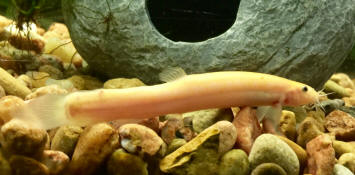
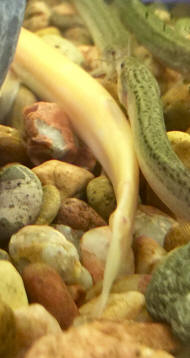
|
Hmmm ... (RMF, any ideas?). G Loach
11/21/17
Good day!
Thank you for the info Saturday.
<Welcome.>
I replaced the carbon filtration back in the tank, water parameters are great at
Amm 0, Nitrites 0 & Nitrates 20 ppm. Ghosty is still eating & acting normally,
and the spots in his two tail lumps are more of a brownish red than bright red
now. They also appear to be shrinking slightly.
<Promising.>
However, this morning, he looked like this:
See that pink squiggly stuff beside him? Is that his skin?
<Is it attached to him? Or just some random thing on the ground? If attached to
the body, then yes, a piece of skin is possible I suppose. More ominously is
some sort of external parasite. It doesn't look much like an Anchor Worm in the
photo, but said photo isn't too sharp, and Anchor Worms are commonly seen on
coldwater fish, so could get onto a Weather Loach at some point. Anchor Worm is
a pain to treat, needing specific medication (because it's a crustacean rather
than a worm) but this sort of shapeless worm might more probably be some type of
flatworm or annelid worm, in which case Praziquantel is your go-to medication.
It's easy to buy and use, not particularly toxic (though use carefully) and is
normally tolerated well by loaches.>
I added Stress Coat to the tank Sat & Sun thinking that might help boost his
healing. I also added Melafix yesterday (although I’ve seen you say this is
useless) ... but with the carbon still in, I would imagine it has been processed
out of the tank ...
<Melafix is fairly pointless, yes. It's kind of like a bar of soap. Sure, might
kill germs on the outside. But doesn't really do much for fish that are
genuinely sick. BobF believes it actually has a counterproductive effect. So
nope, I'd not put a lot of store by it, though I do know some swear by it.
Certainly, if you're treating a bacterial infection, a proper antibiotic like
Tetracycline will be not only more effective but also less likely to affect the
filter bacteria.>
Should I do another course of antibiotics or ParaGuard? Another medication? Or
just wait it out? I’m so sorry to keep asking questions but I’m afraid you’re
the most knowledgeable source & I'm doing all I can to try and help this guy.
:-/
<If he's eating and behaving normally, and that thing isn't attached to him, I'd
carry on what you're doing. But if that thing is attached to him, then treating
as per a worm of some kind should do the trick.>
Thanks in advance for your assistance,
Wendy
<Cheers, Neale.>
<<Don't know what the anomalous material is (fecal matter?), but not a fan of
Melafix. Have Wendy search for our input on WWM re. I would NOT treat this Dojo
further. Bob Fenner>>
|
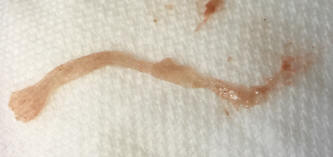 |
|
Ghosty 11/21/17
Ok so I fished it out of the tank, & it is slimy & immediately dissolves when
touched. There were two “blood globs” where those tumors or cysts are, that as
you can see, flattened out w/the slightest pressure.
So strange ... I look forward to hearing your thoughts. Thank you! -Wendy-
Wendy ��
<My thoughts run along the lines of "yuk". But as previous message, if not
attached to loach, and your fish is basically happy and active, I'd fish out and
ignore; stick with optimising living conditions and diet, and trust the loach's
own immune system to do the rest. Cheers, Neale.>
Re: Ghosty 11/21/17
Ok great, thanks very much! It’s just the weirdest thing! Those cysts almost
look as if they’re trying to “pop” or something. Very strange though I suppose
I’m thankful he has this issue & not some of the other lumps & bumps I’ve seen
since scouring the Internet for images of weather loaches with bumps!
<Do try Loaches.com; they do have a forum there, and the guys and gals there are
generally very helpful and informative.>
Thanks again!!
Wendy
<Most welcome. Neale.>
|
 |
|
|
|

